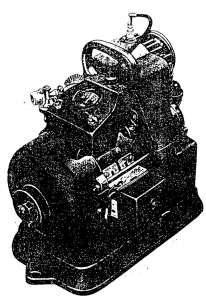Tiny Tim Chargers
During the 1950s, Continental Motors Corporation manufactured the Tiny Tim chargers. Listed below are the various models of the Tiny Tim Charger and some data regarding them.
| Model | Generator Data | Cycle | Bore | Stroke | Gas Tank Capacity | Displacement | Compression Ratio |
|---|---|---|---|---|---|---|---|
| L-62 | 6 Volts 240 watts | 1 | 1-3/4″ | 1-3/4″ | 2 qts. | 4.2 Cu. In. | 4.13:1 |
| L-122 | 12 Volts 300 watts | 1 | 1-3/4″ | 1-3/4″ | 2 qts. | 4.2 Cu. In. | 4.13:1 |
| L-322 | 32 Volts 300 watts | 1 | 1-3/4″ | 1-3/4″ | 2 qts. | 4.2 Cu. In. | 4.13:1 |
Tiny Tim Engine Generators
These engine generators were designed for battery chargers. The charging rate of the average battery is as follows: 6-volt = between 6½ and 7½ volts, the 12-volt = between 13 and 15 volts, and the 32-volt = between 33 and 36 volts. The ampere-charging rate of the charger meets these requirements.
Engines
The engine is of the single-cylinder, four-cycle, “L” head, internal combustion, and air-cooled type. The Lo-Ex aluminum piston has two compression rings and one oil ring, forged aluminum connecting rod, crank pin bearing 5/8 dia. by ¾” long and piston pin bearing 25/64″ dia. by 5/8″ long. A ventilating fan, incorporated as part of the flywheel, rotates on the crankshaft, driving off engine heat and circulating fresh air to the engine and generator. Also, the engine could contain either a 6-, 12-, or 32-volt battery ignition with resistance coil and timer.
Lubrication
Lubrication is by the splash system from the crankcase, with a splash arm on the connecting rod. The crankcase’s oil capacity is one pint. The gasoline is carried in a compartment recessed in the engine’s cast-iron base. The gasoline tank’s capacity is two quarts.
Generator
The generator is coupled to the engine, the armature being wound directly on the crankshaft. The generator requires no lubrication, provided it is of standard automotive or radio size. The 6-volt unit will charge four batteries at one time, while as many as four 12-volt batteries of standard size may be charged with the l2-volt plant. The time required to charge the batteries depends on the number of batteries being charged.
How to Start the Engine
The generator is self-cranking from the battery’s push-button starting switch.
The ignition system of these chargers is for 6, 12, or 32 volts, depending upon the charger in question. Starting ignition is withdrawn from the battery. When the charger is in operation, ignition is obtained from the system as the current cut-out has opened and draws ignition from the generator. If, for any reason, you should desire to stop the engine before the battery is fully charged and the automatic cut-out operates, the ignition may be shorted by pressing the spring anchored to the engine baffle against the spark plug.
The charger cannot be operated without a battery, and no attempt should be made to draw current directly from the generator. A maximum load of 240 watts with the 6-volt and 300 watts with the l2-volt or 32-volt plants may be connected across the battery. Any greater load will cause discharge of the battery.
The engines of these chargers are not intended or claimed to be large enough to operate power appliances either directly or indirectly, as the horsepower rating of the engine is approximately one-half of one horsepower.
These chargers are equipped with an automatic voltage cut-out which grounds the ignition when a battery is fully charged, thereby automatically stopping the charger and eliminating the danger of battery overcharge. The cut-out is adjusted at the factory to react properly with the average automotive or radio-type battery; however, battery conditions and length of terminal connections may sometimes alter and restrict the current flow. If it is determined that the cut-out is not operating properly, it may be readjusted. No adjustment should be attempted to increase or restrict the voltage output. The unit stops automatically when battery is fully charged. The generator has four poles with four brushes.
(Source: Some of the data are from “Tiny Tim Manual”)
